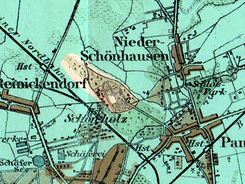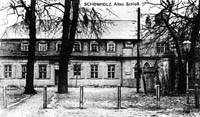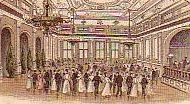Volkspark Schönholzer Heide
| Volkspark Schönholzer Heide | |
|---|---|
| Park in Berlin | |

|
|
| Site plan of the Schönholzer Heide, 1894 | |
| Basic data | |
| place | Berlin |
| District | Niederschönhausen |
| Created | 19th century (gradual design) |
| Newly designed | Late 20th century |
| Surrounding streets |
Friesenstrasse (northeast) , Hermann-Hesse-Strasse (south) , street in front of Schönholz, Waldsteg (northwest) |
| Buildings | Systems in the Volkspark |
| use | |
| User groups | Foot traffic ; Leisure , events |
| Technical specifications | |
| Parking area | 35 hectares |
The Volkspark Schönholzer Heide in the Berlin district of Niederschönhausen , locality Schönholz , is a largely natural, hilly forest park with an area of around 35 hectares . It is a remnant of the previously large closed forest area (Schönhauser spruce) up to the Jungfernheide .
history
In the early 1750s, Queen Elisabeth Christine bought land here for a mulberry plantation . As the wife of Frederick II , she was banished to Schönhausen Palace in Niederschönhausen. The plantation, which is part of the Niederschönhausen Palace Park, was called the Queen Plantation .
From 1763 the queen settled twelve colonists , linen weavers and cloth makers from Saxony and Thuringia , possibly also from Swabia , on the edge of the plantation . The Tuchmacherweg refers to this time .
The colony was called Schönholz from 1791 and from the middle of the 19th century the Queen's Plantation developed into a small estate. The richly furnished manor house, later known as the “Old Castle”, was built here around 1800, and from 1872 to 1884 Henriette Jenrich's high school for girls was housed here. The Berlin Rifle Guild had it largely demolished at the beginning of the 20th century.
The Pankow V cemetery on Tuchmacherweg goes back to the colonist settlement and was closed in August 2007 without the right to subsequent burial, so that this area can be freely used from 2037.
Soil speculation and far-reaching development plans, triggered by the building boom of the Wilhelminian era, threatened the forests on the heath around the turn of the century. The site should be parceled out and sold. With the support of the mayor of Pankow at the time, Wilhelm Kuhr , the citizens' association “Rettet die Heide”, founded to save the heath, was able to stop the deforestation and preserve the heath in its origins.
From the end of the 19th century, the Schönholzer Heide developed into a popular excursion destination, favored by its location on the Berlin Northern Railway, which opened in 1877 . In the course of the incorporation of Niederschönhausen and Schönholz into Berlin in 1920, the Schönholzer Heide was redesigned.
In addition to restaurants and the shooting range, there were now tennis courts and a soccer field. Around 1927/1928 a toboggan hill was created from the excavation of the construction of the extension of the then main underground line to Pankow. The newly built Schloß Schönholz restaurant was set up using the remains of the old manor house and, above all, a large hall was added. A community of showmen who were looking for a new festival area after the closure of the Luna Park in Halensee in 1936 rented an area here from the Berliner Schützengilde and opened the Traumland amusement park , whose main attraction was the 18-meter-high Himalayan Railway . Furthermore there were u. a. a Ferris wheel , a dance pavilion, the Bayernhalle by Franziskaner Bräu in Munich and the dream city of Liliput , which, not uncommon at the time, displayed small people in a miniature world.
With the beginning of the Second World War , from 1940, the Luna Park served as a "Luna camp" for foreign forced laborers . The warehouse was created on the initiative of the Deutsche Waffen- und Munitionsfabriken AG and became the second largest warehouse in Berlin. The foreigners accommodated here were, depending on their country of origin, used primarily for forced labor in the Bergmann electricity works in Wilhelmsruh and for NS armaments companies in Reinickendorf . In addition to the barracks, Schönholz Castle itself was set up as the "Schönholz Poland Camp".
In 1943, space was needed for the inner-city bomb victims. The municipal cemetery Pankow VI was created on a large park area north of today's Hermann-Hesse-Strasse behind the shooting range. When no more war victims had to be buried in 1946, it was partially closed and finally closed in 1981. Use ended in 2006, and the area has been free for subsequent use since 2016.
Between 1945 and 1947, the Schönholzer Heide served the Red Army as a storage area for dismantled factory equipment.
Systems in the Volkspark
Sports facilities
The spacious meadows were used extensively by citizens from Berlin and Pankow. In 1890 the first Berlin celebrations took place on May 1st in the Schönholzer Heide. At the end of the 19th century, Schönholz became known as an excursion destination due to its location on the Berlin Northern Railway .
This is where the Berlin Rifle Guild from 1433 met on their shooting range. In 1880 the rifle guild acquired the estate with the old Schönholz Palace for 240,000 marks . She was able to sell her previous domicile on Linienstraße in Berlin for 1.31 million marks. Thus the construction of an excellently equipped shooting range including shooting range could be financed. The square was inaugurated in 1884. In 1890 the 10th German Federal Shooting took place in these shooting ranges . The shooting range and the castle were bombed out in World War II and the 26 hectare shooting range was confiscated by the authorities. After the German reunification , the area of the rifle guild was not overwritten. The members of newly founded clubs, including the Schützenverein Schönholzer Heide e. V. have been training on the site since 1991.
The Pankower Lawn Tennis Association was formed in 1896, which then became the Association for Movement Games (VfB) Pankow on September 28, 1899 . The Academic Gymnastics Club (ATV) had its venue in the Schönholzer Heide. The footballers of VfB Pankow had their football field here in the 1920s and 1930s.
Ifa film studio
The Schönholz Palace was converted into an artificial light studio by the film director and producer Robert Meinert for the International Film A. G. (Ifa), which he co-founded in November 1921, in which silent films were produced.
In 1922 the silent film Marie Antoinette (The Life of a Queen) was produced by Rudolf Meinert . After the successful censorship on October 21, 1922, the 3134 meter long film (about 67 minutes) was premiered in the Alhambra cinema in Berlin on Kurfürstendamm .
In the summer of 1928, the first speech fiction film was made in the Ifa studio under the direction of Max Mack using the Tri-Ergon system . Its title is One Day Film . It was approved by the censors on September 11, 1928 and performed on September 12 in the Berlin Mozart Hall with a length of 552 meters (20 minutes). The actual premiere was on October 11, 1928 in the Terra-Lichtspiele in Frankfurt am Main . After the bankruptcy of the Ifa in November 1928, the studio was no longer used.
Memorials
In the vicinity of an above-ground bunker that was used at the end of the Second World War and which belonged to the forced labor camp, there is the honor grove for victims of war and tyranny with permanent right of rest on a fenced and ivy- covered area . On this former part of the Pankow VI cemetery there are 352 individual graves of forced laborers, but also of Pankow war victims. Pankow civilians, members of the Volkssturm and an SS man who were bomb victims of the camp's guards rest here .
In the western section of the park on the other side of Germanenstrasse, the Soviet Schönholz Memorial was established in 1949 with 13,200 individual graves. The dead were reburied here from nearby grave sites and put together. The number of people buried was given as 11,000 in the 1960s; the documents handed over in 1992 showed the number of 13,200 people buried here. In addition to soldiers who fell during the fighting for Berlin, prisoners of war are also buried in the rear part. There is also a plaque for them behind the obelisk. This is a peculiarity insofar as Soviet prisoners of war under Josef Stalin were generally seen as potential collaborators . The difference in the information given by those buried here is also due to the deceased prisoners of war buried here from the surrounding camps.
In the south, the Schönholzer Heide is bordered by Hermann-Hesse-Straße. The Pankow III municipal cemetery and the Bürgerpark are part of the former “Schönhauser Fichten” forest area .
Between 1950 and 1990
In the mid-1950s, the Pankow council meeting decided to revive the Schönholzer Heide as a place of amusement and recreation, but this failed primarily for two reasons: On the one hand, the presence of war graves contradicted the idea of a recreational area, and on the other hand, the Schönholzer Heide was in close to the border with West Berlin . After the Wall was built in 1961, Wilhelmsruh station was on the West Berlin side. The Schönholz station is also on West Berlin and the track belonged to the western suburban railway network. It was therefore only open to the West Berlin side. For East Berliners, the journey became more difficult and the Schönholzer Heide quickly lost its importance as a destination, certainly due to its proximity to the border fortifications. The open-air stage Heide-Theater with 2500 seats was opened in the southern part of the park on August 15, 1956 , but it was closed again after the wall was built.
Situation since the 1990s
After the fall of the Berlin Wall , the Schönholzer Heide became increasingly important as a local recreation area. A nature trail has been running through the entire heath since the beginning of the 21st century , there are lawns, an adventure playground and a soccer field. The Rakatak Drummer Festival has been held annually in June in Schönholzer Heide since 1995. At this festival in the shooting range, percussion instruments from different nationalities and with different rhythms are performed every year . In the grounds of the Schönholzer Heide (northwest of the cemetery grounds, south of the memorial for the fallen Soviet soldiers) a plane tree has been designated as a natural monument .
traffic
The Schönholzer Heide can be reached by S-Bahn from Schönholz station or from Berlin-Wilhelmsruh station , and buses from the Berlin transport company also run on the side streets.
Until the Berlin Wall was built in 1961, the park could also be reached by trams on lines 19 and 88.
Use of the name and occurrence in a song
- A large grassy space is a 1927-built retirement home (by the founder, the City Council Krug as a pension institution or a hospital specified) in Niederschönhausen near the Heinrich Mann square serves as a retirement home since the 1990s. To operate from 1996 was Social Service Agency and the Berlin Senate , the Schönholzer Heide Foundation founded.
- At the amusement park, the third verse is reminiscent of the famous, the people of Berlin kept streets Hauer Bolle traveled recently at Pentecost :
On the Schönholzer Heide,
there’s a brawl,
And Bolle, no cowardly,
Was there in the middle, pulled out
knives
and massacred five.
But Bolle
Janz still had a lot of fun .
literature
- Andrea Rudorff, Ulrike Huhn: The Schönholzer Heide - From a place of amusement to a memorial . text · verlag, Berlin 2007, ISBN 978-3-938414-47-7 .
Web links
Individual evidence
- ↑ Entry in the Berlin State Monument List
- ↑ a b c d Museum Association Pankow (Ed.): Schönholzer Heide. From a place of amusement to a memorial. Berlin, 2007, ISBN 978-3-938414-47-7 , pp. 13-25.
- ↑ a b Von der Königinnen-Planatage zur Schönholzer Heide , accessed on April 23, 2014.
- ↑ a b c d VVN-BdA Berlin-Pankow e. V .: The history of the Schönholzer Heide - mirror of the Pankow history . Heather movie
- ↑ Entry in the Berlin State Monument List
- ^ List of shooting clubs in Berlin-Pankow, which u. a. are located on the site in the Schönholzer Heide. List of the Schützenverband Berlin-Brandenburg , accessed on May 25, 2013.
- ^ Berlin film studios. A little lexicon. , accessed April 23, 2014.
- ↑ Soviet Cemetery of Honor & Memorial Schönholzer Heide Berlin . In: Berlin's Taiga . June 7, 2018 ( berlinstaiga.de [accessed June 30, 2018]).
- ^ Homepage of the Schönholzer Heide Foundation
Coordinates: 52 ° 34 ′ 35 ″ N , 13 ° 23 ′ 0 ″ E






